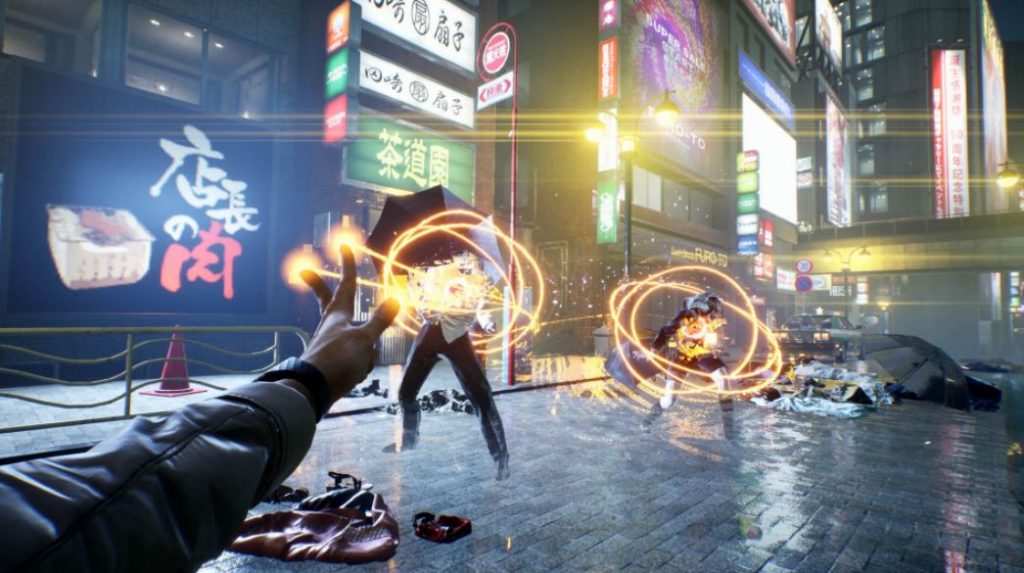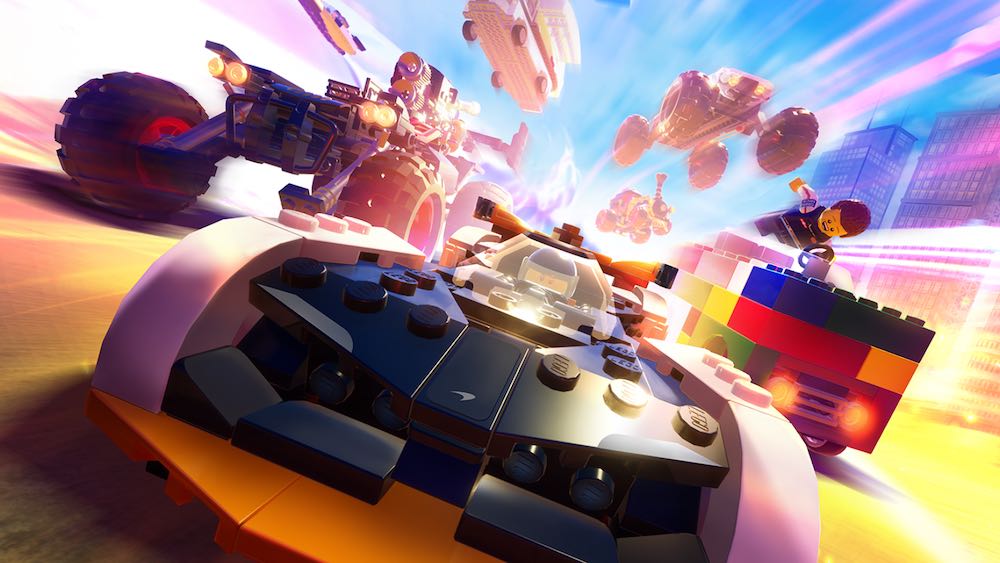Ghostwire: Tokyo Review – Finger Guns!
Ghostwire: Tokyo Review
Ghostwire: Tokyo didn’t quite strike me as a must-play game when it was first announced. The trailers didn’t quite paint an accurate picture of what to expect and the only thing I was leaning on was that it was a first-person action horror game and the final Bethesda game making its way as a Playstation 5 console exclusive developed by Shinji Mikami’s Tango Gameworks.
The premise of Ghostwire: Tokyo is simple: you take the role of Akito Izumi, a troubled youth taking care of his comatose sister, who wakes up in an empty Shibuya where its entire population has vanished. The evil forces behind prepare for a grand ritual that involves sacrificing the souls of The Vanished, including Akito’s sister Mari. Akito must then cooperate with a spirit, KK, to use his newfound spiritual energy to combat malevolent spirits known as the “Visitors” and restore order to Shibuya.
I’ve seen too many games in my lifetime with similar themes (SMTV, TWEWY, etc). Hell, the main plot of Alice in Borderland involves a mass disappearance in Shibuya as the heroes have to solve the mystery of its disappearance by participating in survival games.
The challenge, then, is to see how Ghostwire: Tokyo differentiates itself in this otherwise oversaturated sub-genre of horror featured across different mediums.

Ghosting Tokyo
I find it really difficult to describe the experience of Ghostwire: Tokyo without actually playing the game. The trailers really didn’t do it justice and sold the game short, but what really sets Ghostwire: Tokyo apart is its immersion, arguably its biggest strength. By using its first-person perspective, its near-perfect facsimile of the Shibuya borough, and fully utilizing Dualsense support, Ghostwire: Tokyo brings you as close as you can get to Tokyo without actually being there.
Compared with other games that touch on Shibuya as a setting, Ghostwire: Tokyo provides a unique take on the locale – from the trendy spots of the Scramble Crossing, its unique district of condos seen in Omotesando, and even all the way to Yoyogi Park. If you’re familiar with the area, the detail behind it is really awe-inspiring and creates the perfect setting.
For a good 5-6 hours, I was just examining every alleyway, street corner, and convenience store in the area. You can’t enter all buildings, but the ones that you can provide an accurate image for the types of interiors seen in anime, films, and mangas. By the time that you’re able to grapple towards the flying Tengu’s, adding verticality into the mix sets another layer to explore in Ghostwire: Tokyo. It is actually one game that I totally ignored using fast travel because it diminishes the overall experience.

I’ll get into more on the details of this later, but the Side Missions also expand on the total immersion that Ghostwire: Tokyo has to offer. Each Side Mission tackles different cultural aspects of the area as well as the type of demographic whose lives were abruptly cut off by this phenomenon. You’ll take on requests from office workers, students, and even medieval townspeople, which shows the richness of its animism and folklore encased in a high-tech shell. People really make a place, and the tragic stories of these nameless souls really add to the “life” seen from this world.
Ghostwire: Tokyo also lets you deal with animals and yokai. You’ll be able to communicate with these creatures and be able to see the world from a different perspective, adding to the tragedy that befell this place despite its comedic writing at times.
Given my emphasis on immersion, it has to be said that you won’t get the full effect if you aren’t using Japanese voices for Ghostwire: Tokyo. It really doesn’t feel like Tokyo when everyone is speaking a different vernacular, so at the risk of missing out on some dialogue during busy moments, immersion really trumps accessibility at this point and would be my main recommendation.
The Real Ghost Fighter
While Ghostwire: Tokyo really excels in setting up a sense of place and atmosphere, one thing that it requires a little bit more effort from its audience is its combat and controls. The action is rather straightforward – you blast away your enemies with your elemental attacks and rip their core out as a finisher. Unlike other first-person shooters, there’s a bit of awkwardness in the aiming and firing of these powers, and you’ll constantly find yourself adjusting your sights for the lock-on to take effect again.

Adding to the awkwardness of combat in Ghostwire: Tokyo is the lack of a dodge button, which forces the player to rely heavily on either keeping their distance or utilizing the block / parry system.
Ghostwire: Tokyo sets Akito up with a simple control scheme where you have both a primary and secondary (charge) attack that serves as your main tool for eliminating these ghosts. You are equipped with “Etheareal Weaving” techniques that allow you to fire elemental bursts that can whittle down your opponent (Wind), blast them into pieces (Fire), or slay a whole group with slicing AOE attacks (Water).
The easier difficulties may be tempting for most, but in turn reduces combat to a repetitive slog that boils down to running away, charging your attack, and firing until the enemy dies. At the risk of promoting “git gud”, the harder difficulty setting brings out the best in its combat where enemies become more aggressive, forcing you to think fast and utilize the environment to your advantage. This includes your stealth capabilities, your exorcism powers, and even other tools at your disposal without relying too much on your elemental projectiles.
That said, Ghostwire: Tokyo slightly struggles with enemy variants that do little to differentiate combat styles between each other. The basic black-suit enemies will run at you with strikes, the bigger variants run at you faster, while another stockier variant will run at you with a shield-like umbrella before striking you down with a giant hammer. There are enemies in the latter portion of the game that show off elemental affinities, encouraging a slight change in tactics.
Despite the less than ideal combat, Ghostwire: Tokyo employs good DualSense implementation both in its use of haptic feedback to adaptive triggers. Rainy Shibuya becomes more immersive as you feel the pitter-patter of rain on your DualSense, the tension in rope-like abilities such as pulling cores from Visitors or grappling onto Yokai, and the blasts from your elemental powers that add to the excitement.
Ghostwire: Tokyo also has a feature that utilizes the DualSense touchpad, letting players trace out exorcism symbols. The touchpad can get quite finicky, especially with certain patterns, but choice is not lost here as you can opt to use the right analog stick for more accuracy, or just let KK handle the rest.
Ghost out of the Shell
Thematically, Ghostwire: Tokyo hits it out of the park with an engaging and mysterious main plot that trickles down its to its side elements through every nook and cranny of this game. The atmosphere is creepy and hearkens to every Japanese horror trope in its playbook. The world is united by its unique visual style that even the raindrops are actually the “rain” kanji pouring down from the sky, showing how cursed this world is.
However, this thematic devotion may serve as a potential source of frustration for players. One source of frustration is the Katashiro mechanic of Ghostwire: Tokyo. Besides earning experience by defeating Visitors, Side Quests, and activities, another way to get experience is by absorbing the souls of the departed into Katashiros, containers that encase the collected souls of the Vanished. You can only absorb souls depending on how many Katashiros you have before having to deposit them at payphones. It was fun while it lasted, but having to do this enough times throughout Ghostwire: Tokyo’s duration will definitely feel tedious.
It’s easy to fall in love with the novelty introduced during the earlier chapters, but by the later chapters, you’ll start to see the cracks forming around Ghostwire: Tokyo. Barring a few surprises, the open-world activities are quite repetitive as they follow the same activity in order to net you experience and cosmetic items. It doesn’t stray too far from the tried and tested “open-world formula”, which gives you a ton of map markers and collectibles to uncover.
That said, it is quite baffling that some real elements of horror gameplay were used sparingly such as breaking out of spirit barrier traps, stealth-based missions, and haunted house mazes. You can sort of see ‘The Evil Within’ influences here, and it was disappointing that Ghostwire: Tokyo didn’t lean into the horror aspect more than it did. The game didn’t need to go full survival horror, but the few jump scares and strange art installations got old after a while.

In terms of thematic unity in its lore and exploration that’s linked to its main story, Ghostwire: Tokyo really serves it in spades. I enjoyed picking up clues and recordings scattered through town to paint a picture of the overall plot, and piecing together KK’s backstory really gives us hints of some interesting DLCs down the line.
The emotional core of Ghostwire: Tokyo paints a picture of what humanity has lost by focusing on our own rigid social bubbles and missing out on the big picture of what life has offer. The dichotomy between Akito and Hannya in terms of how they view the nature of death and how each lost spirit deals with the tragedies of their lives cut short by this phenomenon motivated me towards completing activities and continually exploring Shibuya. In fact, if I can continue to do this without the tedium of combat and open-world checklist, I’d happily do so for another 20 hours.
What we liked:
- Tango Gameworks’ unique take of Tokyo comes to life with top-notch immersion combining the Dualsense controls with the first person view
- An expansive tour of Shibuya featuring intricate details of the exterior, interior, underground, and verticality previously unseen in other games of its type.
- Perfect blend of existential horror and visceral horror to create a thematically sound story and world reflected through its many side quests, interactions, and lore.
What we didn’t like:
- Game length could’ve worked better when compressed to a 12-15 hour experience due to repetition and tedium as it went on longer.
- Combat may expect a little more from players and may feel repetitive sooner rather than later.
- Enemy types are limited with uninteresting variants.
Verdict: Buy It!

Ghostwire: Tokyo straddles the line between its respective action and horror genres, where one is significantly more impressive than the other. As an immersive horror title, it combines the rich animist culture of Japan with the modern architecture and atmosphere of Shibuya and blends it majestically, offering a surreal visual experience.
Thematically, Ghostwire: Tokyo succeeds in all accounts as its mood and setting brilliantly stages the central conflict between Akito and Hannya. It takes Tokyo and all its hauntingly empty streets, which reflects the absence of life that Akito holds on to, but conversely also reflects the superficiality of society that Haanya seeks to destroy. In this central conflict, a marriage of both existential horror and visceral horror is in full display, staging a menagerie of Yokai and Visitors for you to encounter and seriously creepy areas for you to explore.
Overall, Ghostwire: Tokyo is a decent game that provides a surprisingly fun time with its open world and intriguing side quests, but it may not be a game for everybody as the action and open-world mechanics will expect some effort from its audience. Despite that, the game deserves a playthrough for its unique immersion and thematic elements, and I hope Tango Gameworks takes this groundwork and improves on it for future titles.
*Ghostwire: Tokyo was reviewed on a PlayStation 5 with a review code provided by the publisher.




